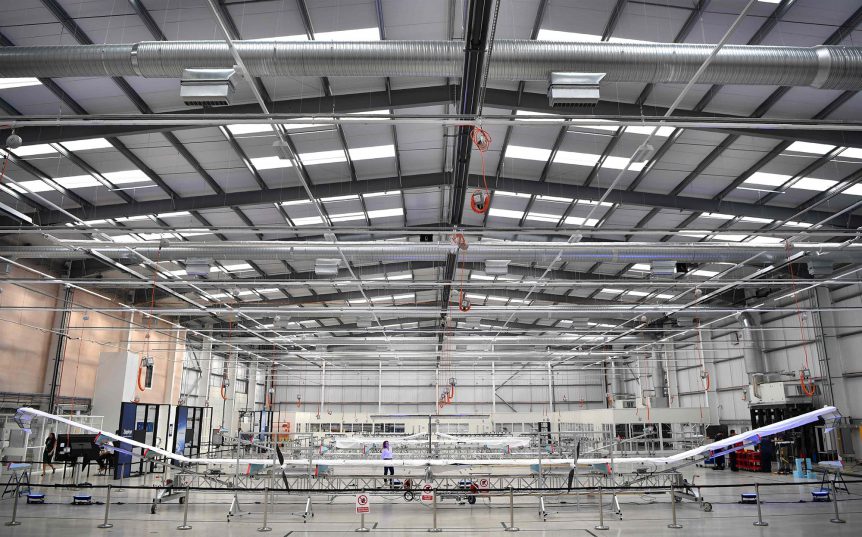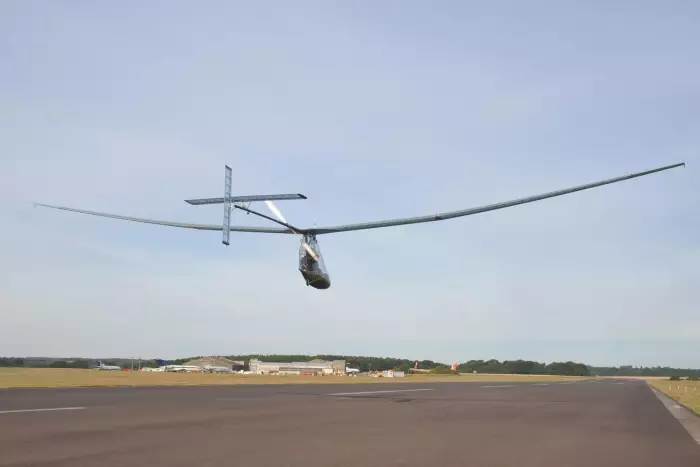Flying high and down under, Amprius, the San Francisco Bay area-based battery developer and maker, announced 450-Watt-hour per kilogram cells, and seemingly immediately secured orders from three major clients. One client of the three is a British specialist in HAPS (High Altitude Pseudo Satellite) aircraft. A probably unrelated sale went to an Australian light plane maker unveiling the country’s “first commercially produced electric aircraft,” a two-seat trainer. BAE/Prismatic BAE Systems has collaborated with Prismatic, a HAPS pioneer, in the development of solar-powered unmanned aerial vehicles (UAVs). The partners have crafted two prototypes of the PHASA-35 unpiloted aerial vehicle, a 35 meter (114.8 feet) span airplane weighing 150 kilograms (330 pounds) capable of carrying a 15 kilogram (33 pound) payload. Solar cells power the craft’s electric motors during the day and charge the Amprius batteries that keep it in the air at night. Amprius claims, “The new 450 Wh/kg cells are the only known commercially available batteries of their kind that …
Zephyr Breaks Its Own Record – Again
The Royal Aeronautical Society, official record keeper for such things, announced in an August 8 press release, “Taking off from Arizona, US on 11 July, Airbus Defense’s solar-powered UAV (unpiloted aerial vehicle), the British-built Zephyr S, has smashed the existing endurance record for unrefueled, unmanned flight by staying aloft for 25 days, 23 hours and 57 minutes. This, the maiden flight of the production Zephyr S HAPS (high altitude pseudo satellite) for the UK MoD (United Kingdom Ministry of Defense), once verified, almost doubles the existing endurance flight record of 14 days, 22 minutes for UAVs, set by a previous Zephyr prototype in 2010. The solar-powered Zephyr UAV, which weighs less than 75 [kilograms – 165 pounds], flies at 70,000ft, above air traffic and weather, to provide a new class of platform for persistent surveillance, observation, communications relay or connectivity for military or commercial customers. Airbus said that the maiden flight saw test objectives met with further flights planned in …
Icarus Cup Achieves New Records
Doing more with much less, British pilots at this year’s Icarus Cup follow in Paul MacCready’s aerial path, staging a highly successful weeklong demonstration of human-powered flight. Airplanes that fly on about a quarter-kilowatt for as long as the human battery can operate the pedals are not new, and significant records have been achieved over the years. The British have long been involved, beginning with the 590 meters flight by Derek Piggott on November 9, 1961 in SUMPAC (Southampton University’s Man Powered Aircraft – note the sexist terminology of the day). This was considered the first authenticated takeoff and flight by a human powerplant. He made 40 flights before suffering a crash that damaged a wing. To help foster interest in human-powered flight, The Royal Aeronautical Society formed the Man Powered Aircraft Group in 1959. Henry Kremer, an industrialist, set up the Kremer prize for a figure-of-eight flight around two markers half a mile (~0.8 Km) apart in 1959. It …
A New British Club for HPAs
For the last six decades, the Royal Aeronautical Society (RAeS) has overseen records keeping for human powered aircraft (HPAs). They report, “The Man Powered Aircraft Group of the Royal Aeronautical Society originated in 1959 when the members of the Man Powered Group of the College of Aeronautics at Cranfield were invited to become a group of the Society. Its title was changed from ‘Man’ to ‘Human’ in 1988 in recognition of the many successful flights by woman pilots.” Mr. Henry Kremer turned the wistful dreams of many to serious competition by donating over 275,000 pounds sterling ($440,000 at today’s exchange rates) in prize money for achievements such as flying a figure eight around to markers a half-mile apart and starting and finishing 10 feet above the ground – won by Paul MacCready, the airplane’s designer and Brian Allen, the pilot. The won their 50,000 pound prize on August 23, 1977, and scored a second win on June 12, 1979 by …
52 Years of Human-Powered Flight
This year’s Icarus Cup, a human-powered flight competition, was held at Sywell Aerodrome, about 75 miles and nearly two hours north of London. The Royal Aeronautical Society hosted the first Icarus Cup last year, and explains its origins and purpose. “In 2011, we commemorated the 50th anniversary of the first flight by a human powered aircraft. The origins of human powered flight begin in 1959, when the Royal Aeronautical Society Human Powered Aircraft Specialist group was formed. Two years later, November 1961 marked the first human powered flight by Derek Piggott. Since then, human powered aircraft enthusiasts have been competing for the Society’s Kremer Prizes . “One of the Human Powered Aircraft Group’s objectives is to promote human powered flight as a sport and encourage wider participation, perhaps one day appearing at the Olympics. The idea of the Icarus Cup was conceived as a way to inspire more people to design, build and fly aircraft themselves and provide an environment for them to …
Lifting Yourself by a Disappearing Thread
The University of Maryland announced the successful 11.4 second flight of an American human-powered helicopter with a female pilot – now the National record holder and successor to the first female flight on such a machine – 17 years ago. In 1994, your editor attended a human-powered aircraft symposium in Seattle at the Boeing Museum of Flight. Paul MacCready signed my copy of Gossamer Odyssey and I was official observer (for Chris Roper of the Royal Aeronautical Society) of the first female-powered helicopter flight. Ward Griffiths, a svelte young thing from a local bike shop, cranked the very similar (to Gamera) thing into the air for 8.6 seconds – a first and a female record at that time. A Japanese gentleman had done 15 seconds the day before and knocked the O. J. Simpson investigation off the front page of the Seattle Post-Intelligencer. Flights took place in the Boeing 777 preparation hangar, while the big jet spooled up and taxied around outside. …



